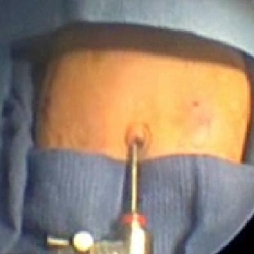Pyloric stenosis
- Overview
- Theory
- Diagnosis
- Management
- Follow up
- Resources
Treatment algorithm
Please note that formulations/routes and doses may differ between drug names and brands, drug formularies, or locations. Treatment recommendations are specific to patient groups: see disclaimer
all patients
intravenous fluid resuscitation
Fluid and electrolyte replacement is paramount to successful management. Surgery must be delayed until hypovolaemia and electrolyte disturbances are corrected. If alkalosis is not corrected, it will prolong the risk for postoperative depression of respiratory drive.
Severely volume-depleted patients should receive a bolus of normal saline prior to initiating fluid replacement.
Intravenous fluid replacement should be provided at 1.5 times maintenance rate with 5% dextrose plus 0.45% saline.
Intravenous fluid should not contain potassium until the urine output is adequate (1-2 mL/kg/hour). Once adequate, 10 to 20 mEq/L KCl should be added.
Surgery can proceed once the serum bicarbonate levels are <28 mmol/L (<28 mEq/dL) and chloride levels are >95 mmol/L (>95 mEq/dL).[1]Aspelund G, Langer JC. Current management of hypertrophic pyloric stenosis. Semin Pediatr Surg. 2007 Feb;16(1):27-33. http://www.ncbi.nlm.nih.gov/pubmed/17210480?tool=bestpractice.com [72]Miozzari HH, Tonz M, von Vigier RO, et al. Fluid resuscitation in infantile hypertrophic pyloric stenosis. Acta Paediatr. 2001 May;90(5):511-4. http://www.ncbi.nlm.nih.gov/pubmed/11430709?tool=bestpractice.com
pyloromyotomy
Treatment recommended for ALL patients in selected patient group
Hypovolaemia and electrolyte disturbances must be corrected prior to definitive surgical management.
Pyloromyotomy corrects the gastric outlet obstruction created by the hypertrophied pylorus.[Figure caption and citation for the preceding image starts]: Laparoscopic port placement.From the collection of Dr Jeffrey S. Upperman; used with permission [Citation ends]. [Figure caption and citation for the preceding image starts]: Laparoscopic knife pyloric incisionFrom the collection of Dr Jeffrey S. Upperman; used with permission [Citation ends].
[Figure caption and citation for the preceding image starts]: Laparoscopic knife pyloric incisionFrom the collection of Dr Jeffrey S. Upperman; used with permission [Citation ends]. [Figure caption and citation for the preceding image starts]: Muscle-splitting manoeuvreFrom the collection of Dr Jeffrey S. Upperman; used with permission [Citation ends].
[Figure caption and citation for the preceding image starts]: Muscle-splitting manoeuvreFrom the collection of Dr Jeffrey S. Upperman; used with permission [Citation ends].
Laparoscopic and open techniques have been reported to have similar risks, although the laparoscopic approach may increase the risk of mucosal perforation (RR 1.60, 95% CI 0.49 to 5.26), and incomplete pyloromyotomy (RR 7.37, 95% CI 0.92 to 59.11), compared with the open approach.[60]Jia WQ, Tian JH, Yang KH, et al. Open versus laparoscopic pyloromyotomy for pyloric stenosis: a meta-analysis of randomized controlled trials. Eur J Pediatr Surg. 2011 Mar;21(2):77-81. http://www.ncbi.nlm.nih.gov/pubmed/20957601?tool=bestpractice.com [61]Oomen MW, Hoekstra LT, Bakx R, et al. Open versus laparoscopic pyloromyotomy for hypertrophic pyloric stenosis: a systematic review and meta-analysis focusing on major complications. Surg Endosc. 2012 Aug;26(8):2104-10. https://www.doi.org/10.1007/s00464-012-2174-y http://www.ncbi.nlm.nih.gov/pubmed/22350232?tool=bestpractice.com [62]Sathya C, Wayne C, Gotsch A, et al. Laparoscopic versus open pyloromyotomy in infants: a systematic review and meta-analysis. Pediatr Surg Int. 2017 Mar;33(3):325-33. http://www.ncbi.nlm.nih.gov/pubmed/27942806?tool=bestpractice.com [63]Staerkle RF, Lunger F, Fink L, et al. Open versus laparoscopic pyloromyotomy for pyloric stenosis. Cochrane Database Syst Rev. 2021 Mar 9;3:CD012827. https://www.doi.org/10.1002/14651858.CD012827.pub2 http://www.ncbi.nlm.nih.gov/pubmed/33686649?tool=bestpractice.com [64]Lunger F, Staerkle RF, Muff JL, et al. Open versus laparoscopic pyloromyotomy for pyloric stenosis - a systematic review and meta-analysis. J Surg Res. 2022 Jun;274:1-8. https://www.doi.org/10.1016/j.jss.2021.12.042 http://www.ncbi.nlm.nih.gov/pubmed/35104694?tool=bestpractice.com
Laparoscopic pyloromyotomy was associated with shorter postoperative recovery time and fewer analgesia requirements than open pyloromyotomy in one large, multicentre international trial.[66]Hall NJ, Pacilli M, Eaton S, et al. Recovery after open versus laparoscopic pyloromyotomy for pyloric stenosis: a double-blind multicentre randomised controlled trial. Lancet. 2009 Jan 31;373(9661):390-8. http://www.ncbi.nlm.nih.gov/pubmed/19155060?tool=bestpractice.com
In centres where laparoscopic surgery is readily performed, it may be the preferred approach.
As most infants with pyloric stenosis are otherwise healthy, there is no preference to perform open versus laparoscopic pyloromyotomy in different patient subsets based on comorbidities.

Choose a patient group to see our recommendations
Please note that formulations/routes and doses may differ between drug names and brands, drug formularies, or locations. Treatment recommendations are specific to patient groups. See disclaimer
Use of this content is subject to our disclaimer